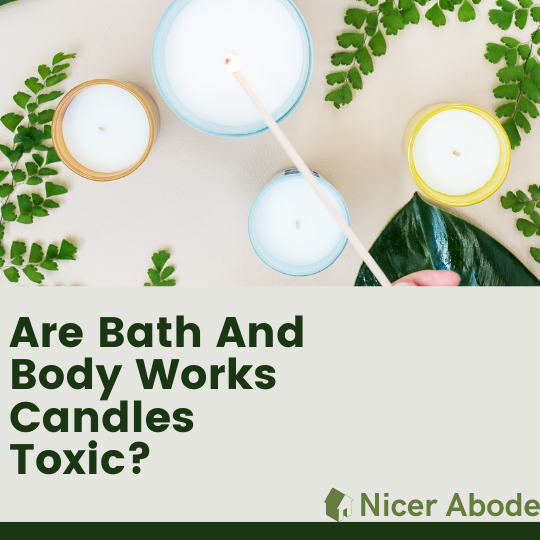Bath and Body Works have been pampering people with its wide variety of scented products since 1990. These products include lotions, body wash, and candles that provide a refreshing fragrance and warm ambiance throughout the house.
However, there is a sinister side, as burning Bath & Body Works candles contain paraffin wax and various synthetic chemicals, which when burned release known carcinogens like benzene and toluene into the air. These toxins have been linked with symptoms like nausea, headaches and even cancer.
People or pets sensitive to these ingredients can develop health issues rather than enjoying a deodorized home. Although these substances make the candle look and smell fantastic, they can cost you more in terms of health damage.
When a candle burns, it releases fumes, and harmful chemicals may be a part of it. You can have a home full of air pollutants that can attack your lungs or enter your bloodstream. These substances can even cause cancer, which can be a higher price to pay just for impressing guests with your aromatic home.
Fortunately, you can find alternatives to deodorize your house without risking your health and resorting to harmful chemicals or fragrances. However, if Bath & Body Works candles are your favorite, it would be best to use them as per the instructions on the label.
Who is it toxic for, you ask?
Toxic for Cats?
Yes, it is. Find my detailed answer here about Bath & Body Works and Cats.
Toxic for Dogs?
Just like cats, your B&BW candles can also cause issues for your dog. Find my detailed answer here about safety of Bath & Body Works Around Dogs.
Toxic for Birds?
Scented candles contain volatile oils, which can be toxic for birds. Like all other pets, birds are also prone to irritation, and your B&BW candles can be the source of this problem. It would be best to light your candles in open spaces with a sound ventilation system and away from birds.
Toxic for Pregnant Women?
Although you might get irritation, allergic reactions, or headaches by lighting B&BW candles, no studies indicate they are toxic for pregnant women.
Analyzing Ingredients
Apart from paraffin candles, Bath and Body Works also sells vegetable wax candles, and thus the primary ingredients for these candles are paraffin wax, soy, and vegetable wax.
Paraffin wax is the refined form of petroleum-based slack wax. Since petroleum-derived products can put your health at risk, regular use of paraffin candles can increase the risk of developing cancer. Additionally, it can cause nausea, congenital disabilities, headaches, and respiratory problems.
Vegetable wax comes from plant oils such as coconut, sunflower, and soy. After treating these oils with hydrogen gas, they become saturated fatty acids mixed with other ingredients to produce vegetable wax.
Like we mentioned earlier, candles made from paraffin wax can pollute your indoor environment by releasing volatile organic compounds and particulate matter. When you burn a paraffin wax candle, it releases liquid droplets or solid particles in the air, harmful to your health.
Likewise, volatile organic compounds can cause allergic reactions, irritation, and headaches.
So how do you know if a candle is toxic? It would be best to check whether your candle contains paraffin wax to avoid these problems.
Additionally, you can rub a white paper on a fresh candle’s wick and see if it leaves a gray mark. If it does, that’s the one you should avoid.
Side Effects
Apart from giving you headaches, irritation, and allergic reactions, using Bath & Body Works candles can develop long-term problems for your health.
According to experts, candles that have fragrances contain phthalates, which can disrupt your hormones.
Studies have indicated that phthalates can cause health conditions, such as diabetes and fertility issues.
Additionally, these hormone disruptors can result in breast and liver cancer or even ADHD (Neurodevelopmental childhood disorder).
Do All Scented Candles Give Off Toxins?
My answer would be no. You can consider scented candles made from natural resources, such as organic soy, coconut wax, or Beeswax, which contain essential oils as fragrance.
These candles provide more value to your money and also produce less soot.
For instance, soy wax candles burn longer than paraffin wax candles and are free of toxic pollutants, making them eco-friendly and an excellent alternative for paraffin candles.
Likewise, Beeswax candles are preferable to paraffin because of their ability to clear viruses, pollen, and bacteria.
However, they are not suitable for vegans, and they would have to find a different solution.
Personally, I’m a big fan of the Benevolence candles on Amazon. They use soy wax instead of paraffin wax, and actually last much longer than Bath & Body Works candles.
There is only one downside – the fragrance is too strong when you use them initially. I usually put out the candle after just 15-ish minutes since the room is already filled with fragrance.

Safe Way to Use Bath & Body Works Candles
If you can’t make your mind and want to hold onto your B&BW candles, here are some tips that can help you burn their candles safely:
- Burn your candles away from A/C vents or fans
- Cut your candle’s wick size to 1/8 inch before usage (each time)
- Always choose open spaces to burn your candles with good ventilation
- Do not allow wick ends to fall into the wax
- Do not blow out your candle inside the house
- Use a candle lid or snuffer to extinguish the candle
- Install an air purifier in your home to reduce air pollutants released from the candle
About Bath and Body Works Plug-Ins
Since B&BW plug-ins contain phthalates, VOCs, and formaldehyde, they can be toxic when inhaled. Additionally, there is also a risk of your pets ingesting contents of the B&BW air freshener, affecting their gastrointestinal system.
Further Reading
https://happywax.com/blogs/from-the-blog/7-health-issues-caused-by-paraffin-wax
https://goodlightcandles.com/blogs/news/why-paraffin-wax-is-bad-for-you
https://www.parents.com/pregnancy/my-body/is-it-safe/how-to-avoid-hidden-toxins-during-pregnancy/
https://www.bathandbodyworks.com/
https://en.wikipedia.org/wiki/Bath_%26_Body_Works
https://www.healthline.com/health/are-candles-bad-for-you#scented-candles
https://en.wikipedia.org/wiki/Paraffin_wax
https://www.health.state.mn.us/communities/environment/air/toxins/voc.htm